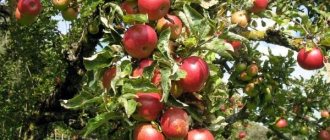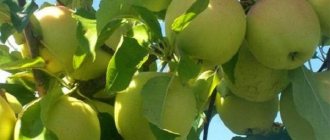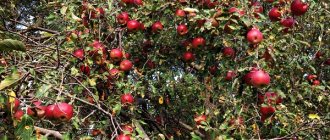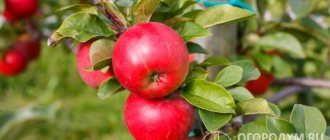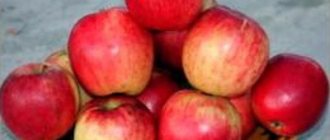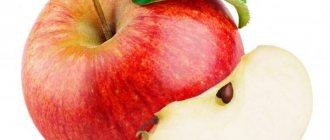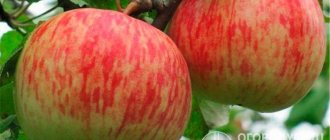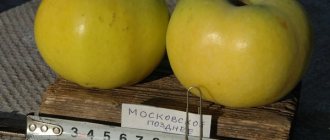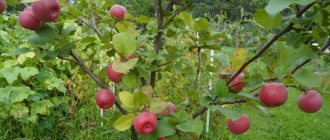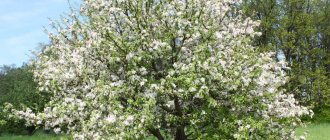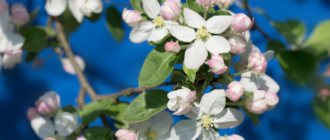Description
The Red Delicious apple tree has been known for a very long time and is considered one of the oldest subspecies of apple trees .
It began to be grown in America more than 100 years ago , and it is also popular in European countries and Russia.
Throughout the entire period of existence of the Red Delicious apple tree variety, breeders carried out work to improve it and develop new subspecies.
It is believed that this variety is a mutation that arose randomly from the classic Delicious variety.
This apple tree is characterized by:
- The presence of a large number of ringlets of different ages; it is on them that the entire crop is formed and ripens.
- The shoots of the tree are either straight or slightly curved, brown in color and slightly pubescent.
- The leaves are medium in size, with a rounded base and an elongated tip of the leaf blade. The edges are shiny and serrated.
Important! The main feature that the Delicious apple tree variety has, by which it can always be distinguished from other apple trees, is the red color of the petiole , which rises up along the veins to the middle of the leaf.
The fruits of the Red Delicious apple tree are conical in shape; moreover, they are distinguished by their ideal appearance and resemble more a beautiful dummy than an edible fruit. The skin of these apples is deep red in color, quite dense and rough, which serves as additional protection from shocks and other mechanical damage.
The flesh is creamy, juicy and crisp.
Red Delicious has been used as a parent variety for the development of such apple subspecies as:
- Winter beauty
- Flame of Elbrus,
- Prikubanskoe,
- Orient, etc.
Tree height and crown width
Apple orchard of young trees.
The apple tree of this variety grows to medium size , which makes it easy to harvest.
In young trees the crown is oval or pyramidal, but by the time of the first fruiting it acquires a round or wide-round shape.
The yield of a variety directly depends on the quality of care; with proper attention, up to 70 kilograms of fruit .
Tasting assessment
Many experts believe that Red Delicious apples have a standard taste and give them the highest possible tasting rating.
These fruits are recommended to be consumed fresh or as part of various salads and snacks.
Important! In addition to excellent taste, such fruits boast a rich chemical composition. They contain large amounts of vitamin C and P-active substances.
Winter hardiness
The fruits of the Red Delicious apple tree are very similar to a dummy.
This variety has sufficiently high winter hardiness to grow it in central Russia.
Residents of the northern regions, Siberia and the Urals will have to cover the tree for the winter using burlap, spruce branches and other available means.
Disease resistance
Red Delicious apple tree has low resistance to:
- Parshe,
- powdery mildew,
- Rot of the seed chamber,
- Vitreousness of the pulp.
During storage, the fruits may develop bitter spot and the entire crop will become unfit for consumption.
Advantages and disadvantages
The advantages of the variety include:
- The fruits are very tasty, large and beautiful;
- Apples tolerate transportation well , and they can also be stored for a fairly long period of time;
- The variety has average winter hardiness;
- The crown of the tree independently forms the correct shape and does not require additional pruning ;
- The apple tree is unpretentious to the composition and quality of the soil.
The disadvantages include:
- The variety does not adapt well to unusual weather conditions;
- An apple tree can be susceptible to a large number of different diseases.
Advantages and disadvantages
The apple tree has proven itself a long time ago - more than 100 years ago. She has more advantages than disadvantages. When purchasing this variety, you should remember that with good care of the tree it is possible to compensate for many weaknesses.
Advantages
- Tasty, beautiful and large fruits;
- High yield;
- The dense peel protects the fruit from damage - good shelf life and transportability;
- Resistance to powdery mildew and fire blight;
- Unpretentiousness to soil composition;
- The crown is formed naturally - the tree only needs sanitary pruning;
- Frost resistance in temperate climates.
Flaws
- Unsuitable for cold regions with harsh winters;
- Susceptibility to glassiness and rot;
- The fruits are not suitable for heat treatment;
- The tree has difficulty withstanding sudden weather changes.
Reviews
Stepan: I decided to grow an apple tree on my plot, I spent a long time choosing a variety and settled on Red Delicious, after studying the description and photo. Despite the fact that this tree was brought to us from abroad, it has taken root well in my Moscow region . Now it is already 5 years old and there have been no problems with growing it, the only negative is the need for frequent watering.
Tatyana: I have been growing apples for many years, but recently I began to notice that my grandchildren, instead of their own, natural fruits, ask to buy them in the store. After that, I consulted with a neighbor, looked at the photo and description of the variety, and decided to purchase a Red Delicious apple tree. When the first apples appeared, they were immediately eaten by all family members, and the harvest goes away very quickly. And most importantly, I know that my household eats natural and healthy foods .
Elena: I read about the Red Delicious variety and decided to plant it at my dacha in Voronezh. Unfortunately, one tree froze after the winter, but the second one is growing and delighting with its most delicious fruits . True, I have to cover it for the winter, because I am afraid that it will also die, but this is nothing compared to how rich the harvest I get. Another good thing is that when all the neighbors run to the store for apples, I eat my own, homemade ones.
Specifications
After assessing external data, gardeners study the properties of plants. These criteria are evaluated and selected more carefully.
Resistance to sub-zero temperatures and drought
The Red Delicious apple tree does not tolerate temperatures below -20 ⁰C. Does not like drought, regular watering is necessary.
Immunity to diseases and pests
There is no immunity to any disease. Mandatory treatment of apple trees against diseases and pests is required.
Recommended growing areas
Due to its positive characteristics, the Red Delicious apple tree is grown in central Russia. Some summer residents from Siberia and the Urals plant apple trees. Only they prepare it more carefully for winter.
Features of planting and care
In order for the apple tree to be healthy and enjoy abundant and regular fruiting, it must be planted correctly and all necessary tree care procedures must be carried out .
Landing
Planting an apple tree in spring.
Deadlines
The timing of planting Red Delicious apple trees directly depends on the location of the garden plot .
In areas with warm and temperate climates, autumn planting is recommended, which takes place from late September to mid-October.
The main thing is that all work is completed a month before the onset of frost.
Advice! Spring planting is used when trees are grown in colder areas with a harsh climate.
Technology
To properly carry out the work of planting an apple tree, it is necessary to prepare the hole in advance and add the following fertilizers to it:
- Humus or rotted manure;
- Wood ash;
- Superphosphate;
- Potassium.
This mixture will make the soil more fertile and help the plant grow faster.
average size of the planting hole
During work , it should be taken into account that the root collar should be 5-7 centimeters above ground level .
After the apple tree is rooted, it is watered abundantly and compacted.
Growing conditions
In order for an apple tree to grow and develop well, it needs to be properly cared for.
Considering that the Red Delicious variety does not tolerate drought well , you need to water the tree in such a way that the soil is always moist. It is also necessary to apply organic and complex mineral fertilizers annually.
Sum of active temperatures
Since the Red Delicious apple tree is a late-ripening variety, the sum of active temperatures will be equal to 2100 degrees. Thus, to successfully grow this tree, it needs at least 140 days with a temperature of at least +10 degrees.
Important! Experienced gardeners note that if there are frosts during flowering and the temperature drops below -1 degree, all fruit ovaries will die and there will be no harvest this year.
Pruning and crown formation
The Red Delicious apple tree requires annual sanitary pruning, during which all dry, damaged and diseased branches will be removed.
Crown shaping involves removing shoots that grow vertically or towards the tree trunk.
All such work should be carried out before the start of sap flow, that is, in early spring (March) or late autumn, immediately after leaf fall.
Pollinator varieties
Red Delicious needs additional pollination . For these purposes, apple tree varieties such as Idared and Jonathan are planted nearby.
Further care for the Red Delicious apple tree
Their growth and future productivity depend on how the planted seedlings are cared for in the future.
Irrigation regime
During the summer season, these trees add moisture at least 5-6 times. 20-30 liters of water are added to the tree trunk circle once. Since the Red Delicious apple tree variety is very fond of watering, therefore, during periods of drought and during the period of active formation of vegetative mass, the amount of watering can be increased.
After watering or rain, you need to loosen the tree trunk circles and mulch them with mown grass or straw.
Feeding
For the active growth of this fruit tree and subsequent fruiting, it is necessary to fertilize the tree trunks of the Red Delicious apple tree several times during the season:
- in the spring, apply 25 g of nitroammophoska near the base of the tree;
- during the budding period, 300 g of wood ash is scattered around the perimeter of the tree trunk;
- During the period of active fruit ripening, 25 g of potassium salt and superphosphate are dissolved in a bucket of water. Watering is carried out in the tree trunk circle;
- When preparing trees for winter, organic matter is added to the tree trunk circle - 5 kg for each square of area.
Trimming
Red Delicious apple trees should be pruned annually. In the first years, the crown is formed; from the 4th season, all branches that grow inside the crown and thicken it are removed, and the shoots are also thinned out. You should also cut out any dried or diseased branches.
At the same time, it is necessary to carry out preventive treatment of the crown of the Red Delicious apple tree with appropriate fungicides against scab, rot and other diseases that can damage this fruit tree.
GOLDEN RULES FOR Pruning APPLE TREE - video
Preparing the apple tree for winter
In the process of preparing for winter, moisture-recharging irrigation should be carried out, phosphorus-potassium fertilizing should be applied, and young trees should be insulated.
Advice!
When growing Red Delicious apple trees in the northern regions, it is recommended to graft this variety onto local winter-hardy rootstocks.
How to prepare apple trees for winter - video
Features of ripening and fruiting
The Red Delicious apple tree blooms late, namely in late spring and early summer. The fruits also ripen late, in late September - early October.
The first harvest of apples of this variety can be obtained already in the 3-4th year of the tree’s life.
Collected apples can last for several months (until April), without losing their freshness and taste.
Also, thanks to their thick skin, they tolerate transportation well . It is for these qualities that these fruits are popular for growing for commercial purposes.
Red Delicious Apple Tree.
Diseases and pests of the variety
Scab is dangerous for the Red Delicious apple crop. Without preventive treatments, the disease can significantly damage apple trees. Slightly less often, fruits are affected by vitreousness and rot.
To prevent possible diseases in the spring, it is necessary to spray the plant with a 1% solution of copper sulfate. If diseases do appear, the affected fruits and leaves must be removed. To treat these diseases, copper sulfate or Bordeaux mixture is used.
Important! The preparations can be toxic to the human body, so when processing, be sure to use protective equipment - rubber gloves and goggles.
Analogs of the variety
In cases where growing an apple tree on a site is not possible due to lack of territory, columnar varieties can be planted.
They are distinguished by their short stature and unusual arrangement of fruits directly on the tree trunk. Among the columnar apple trees, the Red Delicious variety is most similar to:
- Moscow necklace,
- Constellation.
The domestic analogue of the Red Delicious variety is the Zorka apple tree, which is also in demand and popular among gardeners. The fruits of this variety have a conical shape and thick skin, the flesh is very juicy and crispy.
Unfortunately, the Red Delicious apple tree variety cannot be grown as a root tree . That is, its reproduction while preserving all varietal characteristics is possible only by grafting a scion onto a rootstock.
Collection and storage
To pick fruits from the tree, choose a dry, sunny day.
Please note: storing wet apples leads to the appearance of bitter rot.
The fruits are placed in wooden or plastic boxes with free ventilation. If you plan to lay more than 1 layer, paper or non-woven fabric is placed between them.
Red Delicious apple variety
Red Delicious apple variety
Apple tree variety early winter Red Delicious
Growing in different areas
The Red Delicious apple tree prefers a dry climate, warm temperatures during the day and cool at night, so this variety is ideal for growing in the Moscow region and central Russia.
In these areas the tree will feel comfortable and produce a good harvest.
When growing a tree in Siberia, it is necessary to take proper care to protect it from gusty winds and cold weather; to do this, it is covered from autumn until the weather stabilizes.
This is due to the fact that spring frosts are more destructive for apple trees than stable cold weather.
Advantages and disadvantages
Unpretentious apple tree
The variety has perfectly acclimatized to the Russian expanses, spreading in the southern, central and northern regions.
Its advantages include:
- bountiful harvest;
- large fruit;
- beautiful appearance;
- unpretentiousness;
- high immunity;
- fast regeneration.
When growing, it is necessary to take into account the weaknesses. Trees do not tolerate prolonged frosts in the absence of snow. Apple trees will have to be protected from rot and sudden temperature fluctuations. In winter, additional protection of the root system is required. Fruits react poorly to heat treatment, losing most of their flavor.
Video
We offer you to watch videos in which experienced gardeners share their opinions about the Red Delicious variety:
Chemist-technologist by training and an avid amateur gardener. He devotes his free time from work to relaxing at the dacha and caring for plants. She believes that her own garden is the best place to relax. Loves to communicate with experienced summer residents and learn something new and useful. He is happy to share his knowledge with readers.
Found a mistake? Select the text with the mouse and click:
Compost is rotted organic remains of various origins. How to do it? They put everything in a heap, hole or large box: kitchen scraps, tops of garden crops, weeds cut before flowering, thin twigs. All this is layered with phosphate rock, sometimes straw, earth or peat. (Some summer residents add special composting accelerators.) Cover with film. During the process of overheating, the pile is periodically turned or pierced to bring in fresh air. Typically, compost “ripens” for 2 years, but with modern additives it can be ready in one summer season.
You need to collect medicinal flowers and inflorescences at the very beginning of the flowering period, when the content of nutrients in them is highest. Flowers are supposed to be picked by hand, tearing off the rough stalks. Dry the collected flowers and herbs, scattered in a thin layer, in a cool room at natural temperature without access to direct sunlight.
Convenient Android applications have been developed to help gardeners and gardeners. First of all, these are sowing (lunar, flower, etc.) calendars, thematic magazines, and collections of useful tips. With their help, you can choose a day favorable for planting each type of plant, determine the timing of their ripening and harvest on time.
The homeland of pepper is America, but the main breeding work on developing sweet varieties was carried out, in particular, by Ferenc Horvath (Hungary) in the 20s. XX century in Europe, mainly in the Balkans. Pepper came to Russia from Bulgaria, which is why it received its usual name - “Bulgarian”.
Humus is rotted manure or bird droppings. It is prepared like this: the manure is piled up in a heap or pile, layered with sawdust, peat and garden soil. The pile is covered with film to stabilize temperature and humidity (this is necessary to increase the activity of microorganisms). The fertilizer “ripens” within 2-5 years, depending on external conditions and the composition of the feedstock. The output is a loose, homogeneous mass with a pleasant smell of fresh earth.
“Frost-resistant” varieties of garden strawberries (more often simply “strawberries”) need shelter just as much as ordinary varieties (especially in those regions where there are snowless winters or frosts alternating with thaws). All strawberries have superficial roots. This means that without shelter they freeze to death. Sellers’ assurances that strawberries are “frost-resistant,” “winter-hardy,” “tolerates frosts down to −35 ℃,” etc. are deception. Gardeners must remember that no one has yet managed to change the root system of strawberries.
It is believed that some vegetables and fruits (cucumbers, stem celery, all varieties of cabbage, peppers, apples) have “negative calorie content,” that is, more calories are consumed during digestion than they contain. In fact, only 10-20% of the calories received from food are consumed in the digestive process.
Natural toxins are found in many plants; Those grown in gardens and vegetable gardens are no exception. Thus, the seeds of apples, apricots, and peaches contain hydrocyanic acid, and the tops and peels of unripe nightshades (potatoes, eggplants, tomatoes) contain solanine. But do not be afraid: their number is too small.
Both humus and compost are rightfully the basis of organic farming. Their presence in the soil significantly increases the yield and improves the taste of vegetables and fruits. They are very similar in properties and appearance, but they should not be confused. Humus is rotted manure or bird droppings. Compost is rotted organic remains of various origins (spoiled food from the kitchen, tops, weeds, thin twigs). Humus is considered a higher quality fertilizer; compost is more accessible.
https://sadsezon.com/sad/plodovie/yabloni/sorta/r/red-delishes.htmlhttps://fermer.blog/bok/sad/plodovye-derevya/yabloni/sorta-yablon/osennie-sorta-yablon/ 5588-jablonja-red-delishes.htmlhttps://ogorodum.ru/jablonja-red-delishes-opisanie-sorta-foto-i-otzyvy.html

